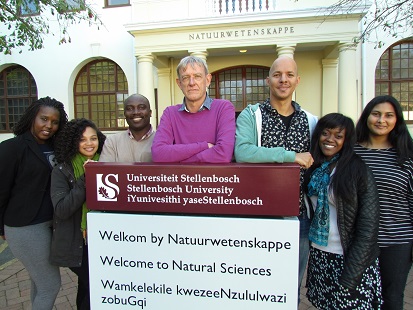The creepy crawlies and other animals which inhabit the misty forests of the Eastern Cape will be the subject of a three-year research project funded by South Africa's Department of Science and Technology.
The proposed study area forms part of the Maputoland-Pondoland-Albany Biodiversity Hotspot and involves scientists from Stellenbosch University (SU) and four other South African universities, as well as Harvard University in the US and six museums.
Prof. Michael Cherry, from the Department of Botany and Zoology at Stellenbosch University and project leader, says that their data and findings could inform decisions on proposed dry gas and titanium mining operations in the area, as well as the new dam planned at Mzimvubu and the N2-Wild Coast Highway.
And should SANParks proceed with the proclamation of the Pondoland National Park, the project could assist with determining the boundaries, he adds.
Degradation of forests
Forests make up only 0.56% of South Africa's land area, and of that the Eastern Cape contains an estimated 46%. These forests display unusually high biodiversity, but to date the faunal diversity of the Eastern Cape's forests have been poorly documented.
"Our forests are experiencing increased pressure for firewood, grazing, and collection of plants for medicine and for other cultural practices," explains Prof. Cherry.
Increasing fragmentation of forests has also affected the ability of animals to move between forest patches: "As the landscape becomes more fragmented, less mobile forest animals, or those that cannot survive in other habitats, may not be able to move between forest patches and this can impact on their survival," he adds.
The study will compare the genetic diversity of populations of more mobile species, such as birds and bats, to more sedentary ones like land snails and shrews.
DNA barcoding of species
Over the next three years the team of 20 research scientists and 22 postgraduate students will use specialised techniques and instruments to snuffle out just about every animal that hides or moves around these forests.
They will be looking out for known arthropods, frogs, reptiles, mammals and birds like the dark-footed shrew, tree hyraxes, bush squeakers, rain frogs, kloof frogs, dwarf chameleons, Natal black snakes, Natal purple gloss snakes, giant legless skinks, harvest-spiders, freshwater insects like mayflies, caddisflies, blackflies, alderflies, as well as bats, the white-starred robin, the chorister robin-chat, fig wasps and even the hard-to-find enigmatic velvet worm.
The big excitement, however, will be to find new, hitherto undescribed, species in these unexplored forests.
Another target will be the DNA barcoding of representative samples of these animal species, as well as of medicinal plants sold at muthi markets in the areas surrounding the forest. DNA barcoding involves sequencing of standard genes for plant and animal taxa across their distributions in order to enable comparisons of genetic diversity.
"Ultimately we hope to establish a digitized reference encyclopaedia of the taxa which inhabit these forests," he says.
The proposed study area forms part of the Maputoland-Pondoland-Albany Biodiversity Hotspot. It includes six different forest ecotypes, three along the edge of the escarpment: Amathole mistbelt forest; Transkei mistbelt forest; and Eastern mistbelt forest; and three along the coast: Pondoland scarp forest; Transkei Coastal scarp forest and Eastern Cape Dune Forest. Within each subtype the team will compare forests and those which are harvested to a greater or lesser extent by local communities. The extent and nature of such harvesting by these communities, and its effects on the forest fauna, forms a critical part of the study.
More about the NRF's Foundational Biodiversity Information Programme
The primary focus of the programme is to generate, mobilize, co-ordinate and make accessible foundational biodiversity knowledge in line with the needs of society, the Department of Science & Technology (DST) Global Change Programme and the bio-economy. The main approach is to fund large, collaborative / integrated team projects which align with knowledge needs, or which involve participants along the entire value chain from knowledge generation to application for decision-making. The Eastern Cape forest project is only the third major grant to be awarded under this programme.
Participating institutions
The core investigators on the project are Prof. Michael Cherry, Prof. Nox Makunga, Prof. Savel Daniels and Dr Victor Rambau, all from Stellenbosch University. Other collaborators are from Walther Sisulu and Rhodes universities in the Eastern Cape, the universities of Pretoria and Cape Town, and Harvard University in the United States. No fewer than six museums are involved including four from the Eastern Cape (Amathole, Albany, Port Elizabeth and East London) plus Iziko Museums of Cape Town and the Durban Natural History Museum. Researchers from the South African Environmental Observation Network, the Agricultural Research Council, Birdlife Southern Africa, the Department of Environmental Affairs and Forestwood CC make up the full complement.

On the photo, from left to right, Judith Kushata (MSc student), Mizzpah Hoffman (Honours student), Dr Victor Rambau, Prof. Michael Cherry, Prof. Savel Daniels, Prof. Nox Makunga and Megan Dreyer (Honours student).

